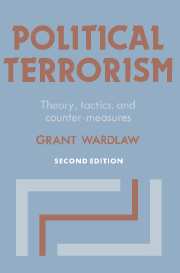Book contents
- Frontmatter
- Contents
- Preface to the second edition
- Preface to the first edition
- Part One An introduction to political terrorism
- Part Two Some selected problems in the response to terrorism
- 8 Counter-terrorist policies: fundamental choices
- 9 Terrorism and the media: a symbiotic relationship?
- 10 The role of the army in counter-terrorist operations
- 11 The legal regulation of terrorism: international and national measures
- 12 Counter-measures against terrorism: the intelligence function
- 13 Terrorist hostage-takings
- 14 Counter-measures against terrorism: the role of behavioural science research
- 15 State involvement in international terrorism
- 16 The future of political terrorism
- Notes
- Select bibliography
- Index
10 - The role of the army in counter-terrorist operations
Published online by Cambridge University Press: 05 January 2012
- Frontmatter
- Contents
- Preface to the second edition
- Preface to the first edition
- Part One An introduction to political terrorism
- Part Two Some selected problems in the response to terrorism
- 8 Counter-terrorist policies: fundamental choices
- 9 Terrorism and the media: a symbiotic relationship?
- 10 The role of the army in counter-terrorist operations
- 11 The legal regulation of terrorism: international and national measures
- 12 Counter-measures against terrorism: the intelligence function
- 13 Terrorist hostage-takings
- 14 Counter-measures against terrorism: the role of behavioural science research
- 15 State involvement in international terrorism
- 16 The future of political terrorism
- Notes
- Select bibliography
- Index
Summary
In recent years, debate has been stirred by the deployment of the armed forces on internal security duties in a number of British Commonwealth countries. In the most noteworthy cases, these deployments have been occasioned by terrorist activities. Since 1969, large numbers of British troops have served in Northern Ireland attempting to contain the activities of the IRA and various Protestant terror groups. In 1970, Canadian Prime Minister Pierre Trudeau invoked the War Measures Act enabling the Federal Government to saturate the Montreal region with troops in an attempt to locate terrorists from the Front Liberation du Quebec (FLQ) who had kidnapped the British Trade Commissioner, James Cross. This Act remained in force for six months and gave sweeping powers of detention for questioning to the security forces. In February 1978 a bomb exploded at the Commonwealth Heads of Government meeting in Sydney, Australia, killing three people. Fearing for the safety of the conference participants, the Federal Government authorised the use of a large number of troops to guard transport routes and to provide security for the meetings. In May 1980, a team from the British Special Air Service (SAS) Regiment assaulted the Iranian Embassy in London, effecting the rescue of hostages being held there by terrorists. All of these incidents have caused considerable discussion about the role of the armed forces in aid of the civil power in response to a terrorist act.
- Type
- Chapter
- Information
- Political TerrorismTheory, Tactics and Counter-Measures, pp. 87 - 102Publisher: Cambridge University PressPrint publication year: 1989



